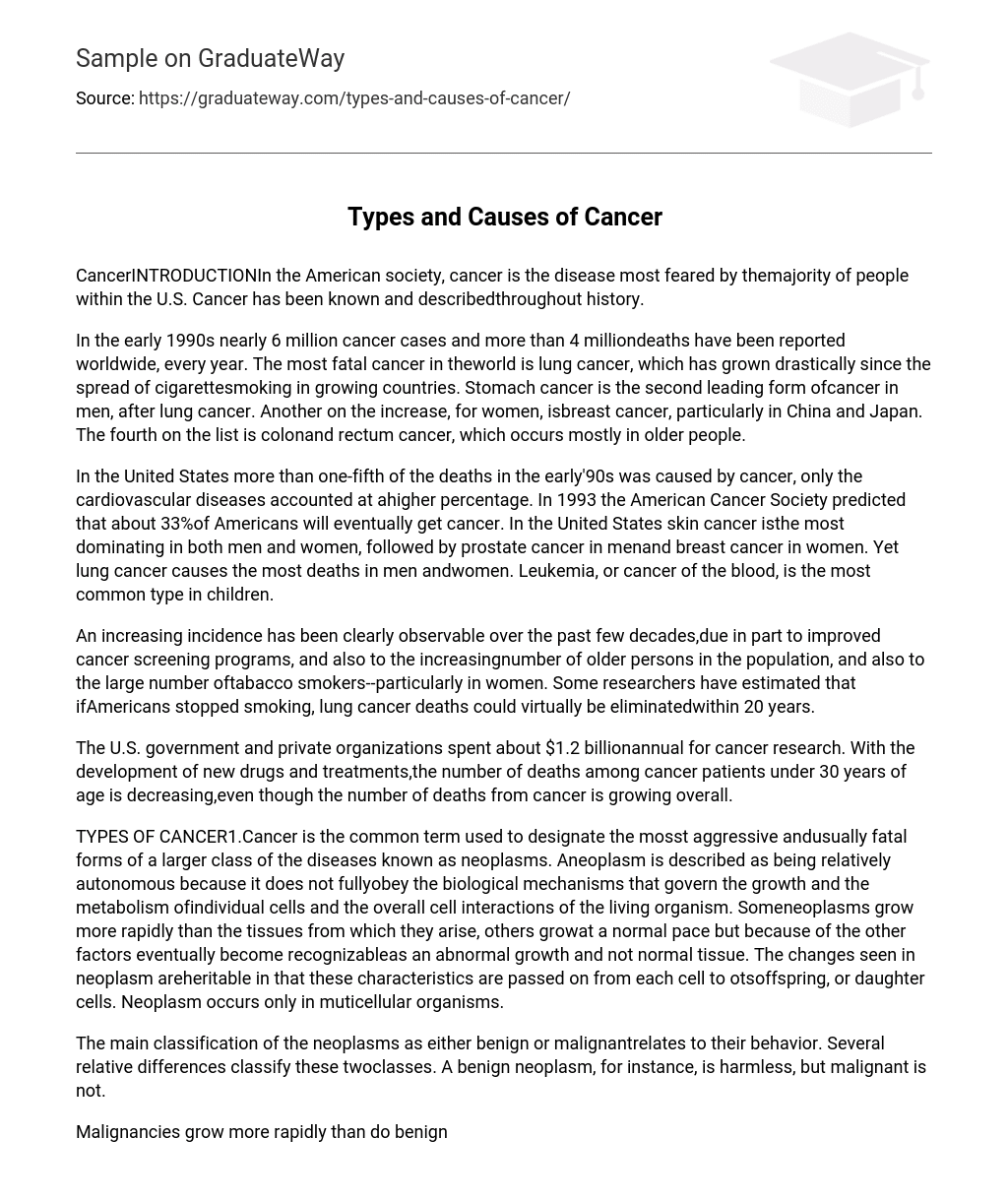In the American society, cancer is the disease most feared by themajority of people within the U.S. Cancer has been known and describedthroughout history.
In the early 1990s nearly 6 million cancer cases and more than 4 milliondeaths have been reported worldwide, every year. The most fatal cancer in theworld is lung cancer, which has grown drastically since the spread of cigarettesmoking in growing countries. Stomach cancer is the second leading form ofcancer in men, after lung cancer. Another on the increase, for women, isbreast cancer, particularly in China and Japan. The fourth on the list is colonand rectum cancer, which occurs mostly in older people.
In the United States more than one-fifth of the deaths in the early’90s was caused by cancer, only the cardiovascular diseases accounted at ahigher percentage. In 1993 the American Cancer Society predicted that about 33%of Americans will eventually get cancer. In the United States skin cancer isthe most dominating in both men and women, followed by prostate cancer in menand breast cancer in women. Yet lung cancer causes the most deaths in men andwomen. Leukemia, or cancer of the blood, is the most common type in children.
An increasing incidence has been clearly observable over the past few decades,due in part to improved cancer screening programs, and also to the increasingnumber of older persons in the population, and also to the large number oftabacco smokers–particularly in women. Some researchers have estimated that ifAmericans stopped smoking, lung cancer deaths could virtually be eliminatedwithin 20 years.
The U.S. government and private organizations spent about $1.2 billionannual for cancer research. With the development of new drugs and treatments,the number of deaths among cancer patients under 30 years of age is decreasing,even though the number of deaths from cancer is growing overall.
TYPES OF CANCER
1.Cancer is the common term used to designate the mosst aggressive andusually fatal forms of a larger class of the diseases known as neoplasms. Aneoplasm is described as being relatively autonomous because it does not fullyobey the biological mechanisms that govern the growth and the metabolism ofindividual cells and the overall cell interactions of the living organism. Someneoplasms grow more rapidly than the tissues from which they arise, others growat a normal pace but because of the other factors eventually become recognizableas an abnormal growth and not normal tissue. The changes seen in neoplasm areheritable in that these characteristics are passed on from each cell to otsoffspring, or daughter cells. Neoplasm occurs only in muticellular organisms.
The main classification of the neoplasms as either benign or malignantrelates to their behavior. Several relative differences classify these twoclasses. A benign neoplasm, for instance, is harmless, but malignant is not.
Malignancies grow more rapidly than do benign forms and invade adjacent normaltissues. Tissue of a benign tumor is structured in a manner similar to that ofthe tissue from which it is derived, malignant tissue, however, has an abnormaland unstructured appearance. Most malignant tumors, in fact, exhibitabnormalities in chromosome structure, that is, the structure of the DNAmolecules that constitute the genetic materials duplicated and passed on tolater generations of cells. Most important, however, benign neoplasms do notbegin to grow at sites other than the point of origin, whereas malignant tumorsdo. The term TUMOR is used to indicate a readily defined mass of tissue that isrecognizable from normal living tissue. Thus a scar, an abcess, and ahealing bone callus are all designated as tumors, but they are not neoplasms.
Besides being classified according to their behavior, neoplasms can alsobe classified according to the tissue from which they arose, and they areusually designated by a tissue-type prefix. A general system of tnonmenclaturehas als arisen to distinguish benign and malignant neoplasms. The designationof the benign neoplasm usually is signified by the suffix-oma added to theappropriate tissue type prefix. Malignant neoplasms are separated into twogeneral classes. Cancers arising from such supportive tissues as muscle, boneand fat are termed sarcomas. Cancers arising from such epithelial tissues asthe skin and lining the mouth, stomach, bowel, or bladder are classified ascarcinomas. Examples of benign neoplasms are a lipoma (from fat tissue) and anosteoma (from bone). Malignant counterparts of these neoplasms are a liposrcomaand an osteosarcoma. The term adenoma is used to indicate a benign neoplasm ofglandular tissue, and corresponding malignancies are termed adenocarcinomas.
Exceptions to this form of nomenclature include thymomas, which areeither malignant or bengnneoplasms of the thymus gland, and such descriptiveterms os dermoid, a benign tumor of the ovary. The suffix-blatoma denotes aprimitive, usually malignant, neoplasm. Leukemia, literally meaning “whiteblood,” is the term used to designate malignant neoplasms having a major portionof their cells circulating in the blood stream. Most leukemia’s arise in theblood-forming tissues, such as the bone and in the lymphatic tissues of the body.
CAUSES OF CANCER
2.A cancer-causing agent– chemical, biological, or physical–is termeda carcinogen. Substances are labeled carcinogens if, when administered to apopulation of previously untreated organisms, thet cause a statisticallysignificant increase in the incidence of the neoplasms compared with theincidence in subjects that are left untreated.





